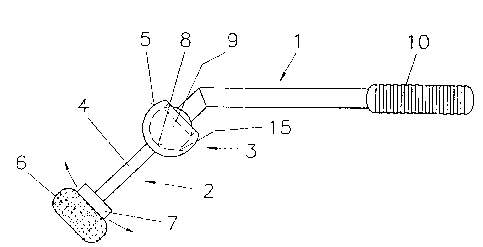Some of the information on this Web page has been provided by external sources. The Government of Canada is not responsible for the accuracy, reliability or currency of the information supplied by external sources. Users wishing to rely upon this information should consult directly with the source of the information. Content provided by external sources is not subject to official languages, privacy and accessibility requirements.
Any discrepancies in the text and image of the Claims and Abstract are due to differing posting times. Text of the Claims and Abstract are posted:
| (12) Patent Application: | (11) CA 2413264 |
|---|---|
| (54) English Title: | MEDICAL INSTRUMENT FOR USE WITH LIQUIDS |
| (54) French Title: | INSTRUMENT MEDICAL POUR UTILISATION AVEC DES LIQUIDES |
| Status: | Deemed Abandoned and Beyond the Period of Reinstatement - Pending Response to Notice of Disregarded Communication |
| (51) International Patent Classification (IPC): |
|
|---|---|
| (72) Inventors : |
|
| (73) Owners : |
|
| (71) Applicants : |
|
| (74) Agent: | SMART & BIGGAR LP |
| (74) Associate agent: | |
| (45) Issued: | |
| (22) Filed Date: | 2002-12-02 |
| (41) Open to Public Inspection: | 2003-06-06 |
| Availability of licence: | N/A |
| Dedicated to the Public: | N/A |
| (25) Language of filing: | English |
| Patent Cooperation Treaty (PCT): | No |
|---|
| (30) Application Priority Data: | ||||||
|---|---|---|---|---|---|---|
|
The medical instrument for the application of liquids
to teeth includes a handle portion and a treating portion,
the treating portion comprising a highly elastic sponge. In
a preferred embodiment, the treating portion is connected to
the handle portion by a ball joint. The use of a sponge
allows an optimum application of the liquid on and in
cavities without leaving residual material. The presence of
a ball joint allows a safe treatment also in locations that
are difficult to access otherwise.
Note: Claims are shown in the official language in which they were submitted.
Note: Descriptions are shown in the official language in which they were submitted.

2024-08-01:As part of the Next Generation Patents (NGP) transition, the Canadian Patents Database (CPD) now contains a more detailed Event History, which replicates the Event Log of our new back-office solution.
Please note that "Inactive:" events refers to events no longer in use in our new back-office solution.
For a clearer understanding of the status of the application/patent presented on this page, the site Disclaimer , as well as the definitions for Patent , Event History , Maintenance Fee and Payment History should be consulted.
| Description | Date |
|---|---|
| Inactive: IPC expired | 2017-01-01 |
| Inactive: IPC removed | 2016-12-31 |
| Application Not Reinstated by Deadline | 2008-12-02 |
| Time Limit for Reversal Expired | 2008-12-02 |
| Deemed Abandoned - Failure to Respond to Maintenance Fee Notice | 2007-12-03 |
| Inactive: Abandon-RFE+Late fee unpaid-Correspondence sent | 2007-12-03 |
| Inactive: IPC assigned | 2003-09-16 |
| Inactive: IPC removed | 2003-09-16 |
| Inactive: First IPC assigned | 2003-09-16 |
| Application Published (Open to Public Inspection) | 2003-06-06 |
| Inactive: Cover page published | 2003-06-05 |
| Letter Sent | 2003-04-22 |
| Inactive: Single transfer | 2003-03-21 |
| Inactive: IPC assigned | 2003-02-18 |
| Inactive: First IPC assigned | 2003-02-18 |
| Inactive: Courtesy letter - Evidence | 2003-01-28 |
| Inactive: Filing certificate - No RFE (English) | 2003-01-23 |
| Filing Requirements Determined Compliant | 2003-01-23 |
| Application Received - Regular National | 2003-01-23 |
| Abandonment Date | Reason | Reinstatement Date |
|---|---|---|
| 2007-12-03 |
The last payment was received on 2006-11-20
Note : If the full payment has not been received on or before the date indicated, a further fee may be required which may be one of the following
Please refer to the CIPO Patent Fees web page to see all current fee amounts.
| Fee Type | Anniversary Year | Due Date | Paid Date |
|---|---|---|---|
| Application fee - standard | 2002-12-02 | ||
| Registration of a document | 2003-03-21 | ||
| MF (application, 2nd anniv.) - standard | 02 | 2004-12-02 | 2004-11-18 |
| MF (application, 3rd anniv.) - standard | 03 | 2005-12-02 | 2005-11-18 |
| MF (application, 4th anniv.) - standard | 04 | 2006-12-04 | 2006-11-20 |
Note: Records showing the ownership history in alphabetical order.
| Current Owners on Record |
|---|
| KERRHAWE SA |
| Past Owners on Record |
|---|
| MARIO BESEK |